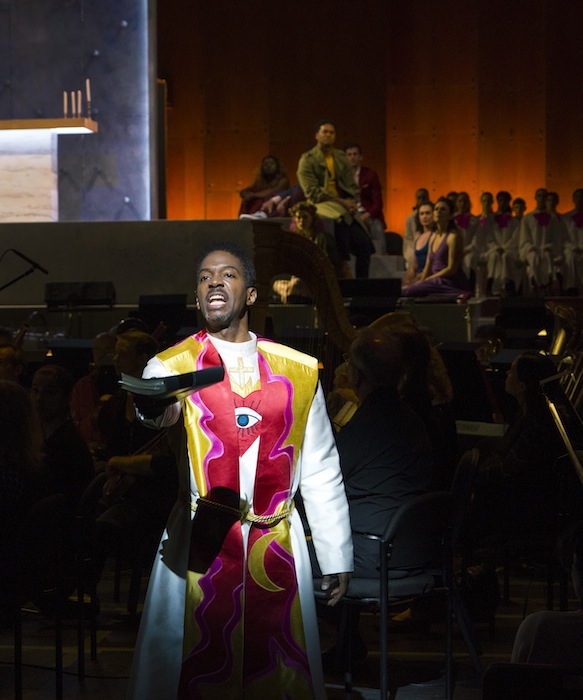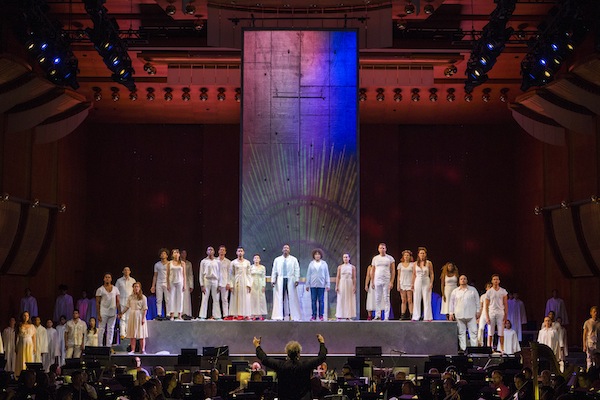Mostly Mozart Festival provides stirring advocacy for Bernstein’s exhilarating, maddening “MASS”

Nmon Ford is the Celebrant in Leonard Bernstein’s “MASS,” performed Tuesday night at the Mostly Mozart Festival. Photo: Richard Termine
Leonard Bernstein’s career challenged the accepted notion that high art and popular culture belong to two different worlds. He moved easily back and forth on the spectrum that extends through and connects the entire range of music, making great musical art in popular styles–as in his most celebrated work, West Side Story–and bringing the Western classical tradition to a broad audience.
His MASS, performed Tuesday night at David Geffen Hall as one of the headlining events at this summer’s Mostly Mozart Festival, collapses that continuum into two hours of exhilarating, maddening music. Bernstein’s grandiose rewriting and re-contextualization of the Latin mass is also something of a culmination of his life, meshing together all his virtues and faults.
The concert showed that no one could fully untangle MASS. This was a stirring and, at times, breathtaking performance by the festival orchestra and performers under the baton of Louis Langrée. Most notable was baritone Nmon Ford’s easy resonance and lovely, butter phrasing as the Celebrant, and a street chorus that delivered one star turn after another. One cannot imagine playing at once so serious and clear, and so sincerely committed. And yet even all that couldn’t ultimately make sense out of the work.
This was in no way a bad experience—a concert that leaves so many vivid memories and that was in the end so deeply moving can fairly be called great. Individual parts of MASS were at times powerful and beautiful, while in others the playing could not turn something bizarre into something sublime.
MASS is dated in that the social, political, and religious views that Bernstein was set on expressing were shaped, specifically in him, by the late ‘60s-early ‘70s mix of liberation theology, leftist revolutionary movements, and hippy society. MASS strives to be groovy, and Tuesday night’s performance was good because it didn’t try to be hip either contemporaneously or retrospectively. With an excellent pace from Langrée, the feeling was concentrated and robust but without heaviness—that cut some of the stentorian edge of Bernstein’s version of the Latin liturgy while giving the pop-theatrical music great warmth, tenderness, and sociability.

Photo: Richard Termine
The classical and theatrical are at odds in MASS. By the time of it’s 1971 premiere, Bernstein’s classical thinking had gone from an expressive, powerful American modernism to an increasingly narcissistic and emotionally confused manner. This side is heard in the orchestra-plus-chorus settings of the mass, which are awkward at best and often a thrashing, incoherent mess. But the music theater parts, the music for the Celebrant and the street chorus, is direct, communicative, impassioned.
This was a theatrical performance, staged at a giant altar set behind and above the orchestra, and fully choreographed (the production comes from the Los Angeles Philharmonic and is directed by Elkhanah Pulitzer and choreographed by Laurel Jenkins). The feeling was a mix of contemporary sleekness with touches of Hair and Godspell, noticeable even before some brief retro-psychedelic projections.
The music theater side was wonderful—musically beautiful and emotionally touching. The theatrical elements extended to the classical sections, with some goofy gestures for the Concert Chorale of New York and the Young People’s Chorus of New York, that failed to work. That underlined how confused Mass is—the mass settings obliterated any sense of mystery or spirituality, while the theatrical music was compellingly ecumenical. The stilted interpretation of “Things Get Broken” underlined how Bernstein didn’t understand what draws people to Christianity–as well as that, despite the sturm und drang, MASS doesn’t have a clear purpose.
At least not when it is in oratorio mode. One was reminded of the unique cultural environment of New York, where the Celebrant and street chorus moved so easily and confidently from classical to Broadway idioms, where everyone could sing and also dance, where boy soprano Tenzin Gund-Morrow nearly stole the show with the sheer beauty of his singing in the concluding “Secret Songs,” where performers did just that, perform the music and theater in every sense.
The orchestral playing was just as important and impressive. MASS is too long and nothing can ameliorate that—yet despite the length of the piece, Langrée and the musicians kept up a driving level of energy without ever being frenetic, even in the riotous orgy of sound in the Agnus Dei, where the orchestra sounded as fresh there as in the opening Kyrie.
MASS will be repeated 7:30 p.m. Wednesday. The Mostly Mozart Festival continues through August 12. MostlyMozartFestival.org


